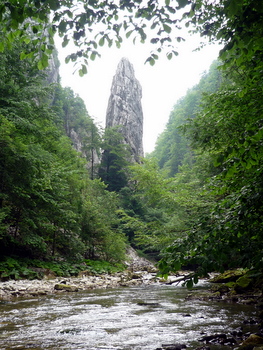Not to be Missed and Other Activities
Chartreuse has more than walking to offer the visitor. This page lists a few of the things that shouldn't be missed. Links for some of the places may be found on the web links page.
Chambéry: Chambéry has a superb medieval centre which is well worth a visit.
St.-Hugues: The church of Saint-Hugues, a couple of kilometres outside St. Pierre de Chartreuse, has some wonderful modern sacred art created by the local artist Jean-Marie Pirot, also known as Arcabas, between 1953 and 1991. His 'Angel on a Bicycle' is an absolute joy.
Musée de la Grande Chartreuse: Although access is not possible to the Grande Chartreuse monastery, there is a museum close by which is well worth a morning's visit. A self-guided tour costing €8.50 (2014), it provides an insight into the history of the order, as well as the life style of the monks.
Grenoble: La Bastille is well worth half a day's exploration (but not on July 14th!).
The Sardinian Way and Les Grottes des Echelles: The former is a superb piece of 17th Century engineering through a gorge that was once the main route between Chambéry and Lyon. The latter are a couple of show caves, one located near the head of the gorge, and one near the foot.
Musée de l'Ours des Cavernes en Chartreuse: This modern and well designed museum in Entremont-le-Vieux (which for some reason the IGN insist on calling Epernay!) was specifically created to exhibit some of the large number of cave bear skeletons discovered in the Grotte de la Balme à Collomb in 1998, and their context. It is well worth a visit - especially if you have previously climbed Mont Granier via the cave.
Le Chateau: The small hamlet of le Chateau above St. Pierre d'Entremont boasts the ruins of the fine Chateau de Montbel dating from the beginning of the fourteenth century. This once massive structure was put to fire on the orders of Richelieu in 1633. From it are fine views to the east.
Le Fort du St. Eynard: This is a beautifully restored 19th Century fort a couple of kilometres south of le Sappey, which is perched on the cliffs a thousand metres above Grenoble. As well as being worth visiting in its own right, the views from the fort and the cliff-top walks are tremendous - well worth a detour on a visit to Grenoble. Unfortunately, the classic way up via the exciting Pas Guiguet was closed by the Commune in 2006 because of the risk of rock fall.
Gorges du Guiers Mort: There is a superb short walk (a couple of hours) between Pont de St. Bruno and the Pic de l'Œillette, a section of which follows the ancient pack horse route into the massif crossing the beautiful seventeenth century Pont Periant. It's well worth exploring the little side paths en route.
The Local Tourist Information Offices: They are mines of useful information, with libraries of local books for reference and leaflets that encourage you to discover the local produce and crafts.
Via Ferrata: For those who have both the expertise and the equipment, there are five via ferrata in the area. The via ferrata de Roche Veyrand is to be found north-east of St. Pierre d'Entremont; the via ferrata les Prises de la Bastille is to be found within the grounds of the Bastille on the outskirts of Grenoble; the via ferrata de Saint Vincent de Mercuze is to be found above Montalieu adjacent to the Cascade d'Alloix; and the Vire des Lavandières and le Grande Dièdre are to be found close to the funicular near Crolles.
Climbing: The scope for climbing in the area is obviously huge, but there are also some bolted cliffs in the area where one can practise in relative safety.
Canyoning: Again, for those who have both the expertise and the equipment, there are a number of equipped canyons in the area.
Swimming: Fine swimming is to be had in Lac d'Aiguebelette near Chambéry, and in Lac de Paladru near Voiron. There is also a modern lido in Les Echelles.

